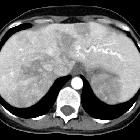Louis-Bar-Syndrom
Ataxia-telangiectasia is a rare multisystem disorder that carries an autosomal recessive inheritance, sometimes classified as a phakomatosis. It is characterized by multiple telangiectasias, cerebellar ataxia, pulmonary infections, and immunodeficiency.
On brain imaging, it usually demonstrates vermian atrophy, compensatory enlargement of the fourth ventricle, cerebral infarcts and cerebral hemorrhage secondary to ruptured telangiectatic vessels.
Epidemiology
The estimated incidence is at around 1:40,000-300,000 live births.
Clinical presentation
The main clinical characteristics include:
- cerebellar ataxia: progressive and present in all cases
- oculomucocutaneous telangiectasias
- greater susceptibility to types of infection (partial combined immunodeficiency ) and neoplasms
Pathology
Genetics
The condition is thought to result from a defective gene located on chromosome 11q22–23.
In less severe cases, termed "ataxia-telangiectasia variants", there is retention of some ATM kinase activity due to either expression of very low levels of normal ATM protein (from splice site mutations) or expression of mutant ATM (from missense mutations).
AT variants are a phenotypically heterogeneous group, characterized by slower progression of clinical signs, an extended lifespan compared to most patients with the classical form of the disease with less cellular sensitivity to radiation, susceptibility to malignancies and recurrent sinopulmonary infection.
Radiographic features
MRI
MRI typically demonstrates cerebellar volume loss and compensatory enlargement of the 4 ventricle.
Additionally, scattered small white matter T2 hypointensities are often identified in patients with ataxia telangiectasia, most likely representing tiny hemosiderin deposits related to thrombosis and vascular leaks from telangiectatic vessels . This imaging appearance can also be seen in amyloid angiopathy, disseminated intravascular coagulopathy and multiple cavernomas . “Gliovascular nodules” within the white matter have previously been described and consist of dilated capillary loops with perivascular hemorrhages and hemosiderosis, surrounded by reactive fibrosis and demyelinated white matter.
Diffuse T2/FLAIR hyperintense signal within the cerebral white matter consistent with demyelination and gliosis has previously been described in ataxia telangiectasia and may reflect ischemia and white matter degeneration due to vascular abnormalities , severe oligodendrocyte and myelin loss , coagulation necrosis and leukodystrophy . A recent study using MR spectroscopy of adult patients with ataxia telangiectasia suggests that the white matter T2/FLAIR hyperintense signal abnormality is secondary to reduced cellularity rather than active demyelination or ischemia .
MR spectroscopy: increased choline signal in the cerebellum has been described as a valuable differentiator from other forms of ataxia .
Treatment and prognosis
As there is no cure (currently), treatment is generally around supportive measures.
Complications
- recurrent bronchopulmonary infection is a frequent complication that can result in permanent lung damage
- there is an increased incidence of malignancy (e.g. bowel and breast cancer)
Differential diagnosis
See differential for diffuse cerebellar atrophy.
Siehe auch:
und weiter:
 Assoziationen und Differentialdiagnosen zu Louis-Bar-Syndrom:
Assoziationen und Differentialdiagnosen zu Louis-Bar-Syndrom:




